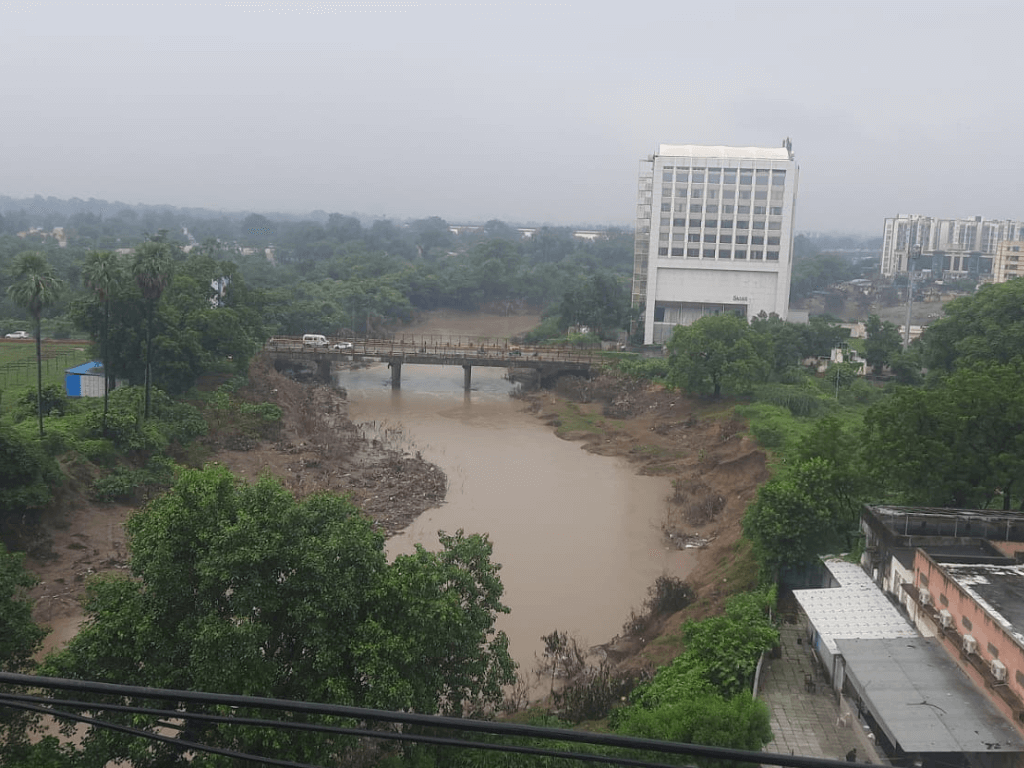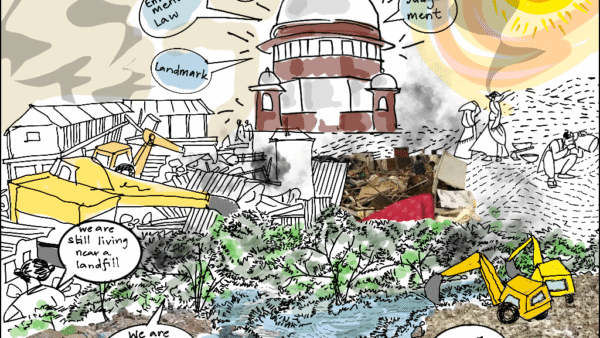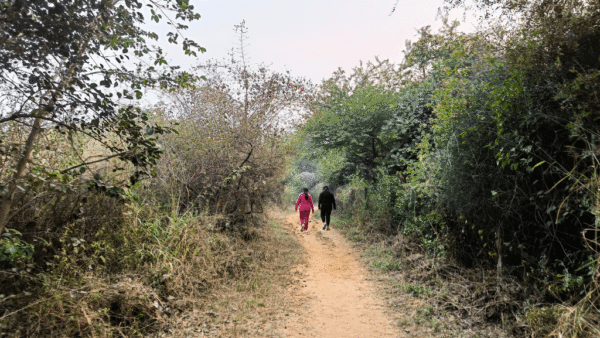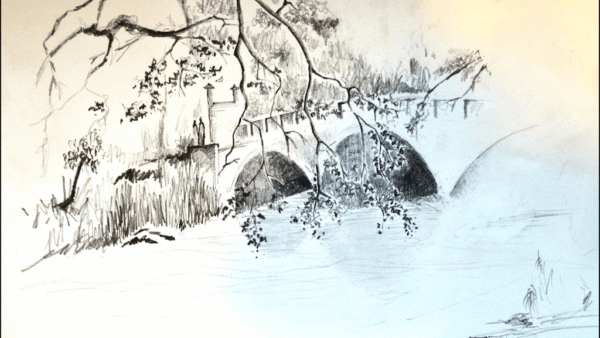The Vishwamitri River[1] cuts through the bustling city of Vadodara, Gujarat. For years, as in any city with rivers, its ecological value went unnoticed and it turned into a drain to carry the city’s filth. The river which spans 100-125 metres wide as it enters the city at Harni squeezes into a narrow, squalid nullah of barely 25 metres, with stagnant water at places. It came to be called the “Gutter Ganga” – till a few residents took matters into their hands, ran awareness campaigns, organised talks by experts and public discussions, made films besides, of course, taking on the Vadodara Municipal Corporation and petitioning the National Green Tribunal and courts to restore – or save – the river.
It’s a stirring story of how environmentalists, urban planners, zoologists, botanists, academicians, students, architects, retirees, professionals and others formed groups and collaborated as the Concerned Citizens of Vadodara (CCV) to ensure that the Vishwamitri would be brought back to life and reconnected with the 2.4 million people of Vadodara – a story captured here[2] in Question of Cities. The coalition has determinedly agitated to get the Vadodara Municipal Corporation and the Gujarat government to clean the Vishwamitri and, importantly, push back on the riverfront development project.
To them all, the devastating floods that paralysed the city for days in August 2024 was a rude jolt. The work on the Vishwamitri had to be up several notches. They have brought renewed energy and focus this past year to truly reflect what a river means to a city. As the flood mitigation work picked up momentum, other aspects of renewing the river ecology like habitat conservation have been taken up. People’s involvement with the river, advocacy, and strategies have been unique to Vadodara.
Their work forced even the Gujarat State Human Rights Commission (GHRC) to take up cudgels suo moto on behalf of the Vishwamitri and appoint, after the 2024 floods, a committee of experts and activists drawn from the movements to oversee official action, including the implementation of the Rs 1,200-crore[3] flood mitigation project approved by the Gujarat government. The committee will keep tabs on the entire watershed, not just the Vishwamitri in the city. And now, there are reflections on the river’s carrying capacity – a subject rarely touched upon.

File photo: Neha Sarwate
Beyond the filth
Despite the work done so far, the Vishwamitri still shows up like any river in a city – narrowed, littered with untreated sewage, stinking – not a place that brings meaning or joy to people. From any bridge, culvert or flyover here, the river is mostly a meandering canal of dark water, almost a gutter. The city’s woefully inadequate or encroached upon drainage and sewer lines, besides unauthorised construction, has continued.[4] If not for the CCV and its dedicated band of environmentalists, activists, and subject experts, the Vishwamitri might have been worse.
“Activities such as the pre-monsoon removal of riverbank vegetation; the filling of ravines with municipal solid waste (MSW) or construction and demolition (C&D) waste; and the modifying of bank topography to re-section and realign the river course all lead to more land being claimed for development. These interventions reflect a lack of ecological awareness and a policy that results in severe alterations to the ecological structure and functions of the river system. Almost all these activities were the initiatives of political representatives or officials in local government, with negligible input or assistance from subject experts,” noted Neha Sarwate and Shishir R Raval in their recent paper on Citizen Intercession Towards Safeguarding the Vishwamitri River[5]
Sarwate, architect-planner who worked in Pittsburgh before moving to the MS University in Vadodara, and Raval, former Head of Department (Architecture) at the University, have been closely associated with the CCV and the many battles fought to save the Vishwamitri. This important inter-weaving of the academia with on-ground activism sets the Vishwamitri story apart from many others in cities. It was seen again this year.
Between June and September, as dredgers worked hard to desilt the river as part of Rs 1,200-crore Vishwamitri Flood Mitigation Project, the committee of experts appointed by the GHRC ensured the sanctity of the biodiversity, specifically crocodiles and turtles. With a daily monitoring schedule, Dr Ranjitsinh Devkar, Assistant Professor of Zoology at MS University,[6] with his band of volunteers spearheaded a rare operation. Every morning, before excavators came to a site, his team scanned the riverbanks for nests and eggs laid by crocodiles and turtles; between March and 7 June, the team had transferred 410 eggs including 88 crocodile, 284 turtle, and 38 bird eggs to Vadodara’s Sayaji Baug Zoo for incubation.
Through the years that I have witnessed, vigilance has been a core part of people’s initiatives – a decentralised, citizen-led, monitoring network to ensure that public funds and executive responsibilities are handled with ecological sensitivity and transparency. “We hold regular meetings to consolidate data, share findings, and communicate updates to the Vadodara Municipal Corporation. This continuous dialogue helps ensure that the rejuvenation of the Vishwamitri is not just done for the people, but with the people,” says Jay Vyas, engineer and activist. “What makes this remarkable is its grassroots nature. There is no one leader; it’s a collective of concerned citizens guided by science, empathy, and love for the city’s natural heritage. It proves that citizens can play a defining role.”

Photo: Nafis Khan
Against the riverfront development
Flood management or mitigation goes hand in hand with pollution control and biodiversity conservation. And people’s involvement has been on all the fronts. However, the pivotal moment would have to be the significant pushback of the Vishwamitri Riverfront Development Project (VRDP) about a decade ago. It was based on the template of the Sabarmati Riverfront Development,[7] a favoured project of the then Chief Minister and now Prime Minister Narendra Modi.
The announcement of the VRDP in 2014, disastrous in ecological terms, saw a motley group of about 100 residents of Vadodara put up a spirited fight. A collective voice took shape; it was more effective than their work in silos earlier. The group identified the problems as concretisation and straightening of the river’s course from its natural meandering, and deployment of heavy engineering machinery on a fragile ecosystem without environment and social impact clearances. Soon, people from different walks of life joined and the movement ensured that the VRDP would not come to pass. From streets and campuses to the Vadodara Municipal Corporation, the National Green Tribunal, and the Supreme Court, they took the fight everywhere. The project was scrapped in 2017. This was a huge victory. That it happened in Gujarat, where dissent in the public sphere was rare, boosted people.
“It all began in 2014 with oral and written representations against the VRDP, signed by some 100 residents, to the municipal and the state authorities. As expected, it did not create the desired impact. So, we moved the NGT with strong documentation like scientific presentations, evidence of unauthorised constructions in the river’s riparian areas, and how the river’s course was being diverted,” recalls environmentalist Rohit Prajapati of Paryavaran Suraksha Samiti and the spearhead of the movement. Prajapati has been agitating for the Vishwamitri and other rivers since the mid-1980s.
Urban planners, environmental science experts, and people from different walks of life pointed out to the NGT that the authorities had not procured necessary environmental clearances and there was a lack of holistic restoration efforts. The NGT issued an order in May 2016 restraining the Vadodara Municipal Corporation from undertaking any activity without requisite clearances. “But it was not as simple,” points out Sarwate, “Despite the NGT’s directive, the municipal corporation continued construction activities along the river. So, we moved a contempt petition in the NGT which led to the setting up of a committee to ensure compliance.” The committee had representation from petitioners like Rohit Prajapati and experts.
“Over the last few decades, the river environs have witnessed multiple instances of damaging interventions – such as formally approved permanent encroachments by developers – as a result of ad hoc zoning changes and apathy amongst the educated classes,” pointed out Sarwate and Raval in their paper. Instead of addressing the burning issues, the VRDP[8] would have worsened them with concrete structures, points out Prajapati. Raval drafted the first petition to the Chief Minister and all authorities after he read the feasibility report. Signed by more than 100, it demanded that the VRDP is reconsidered.
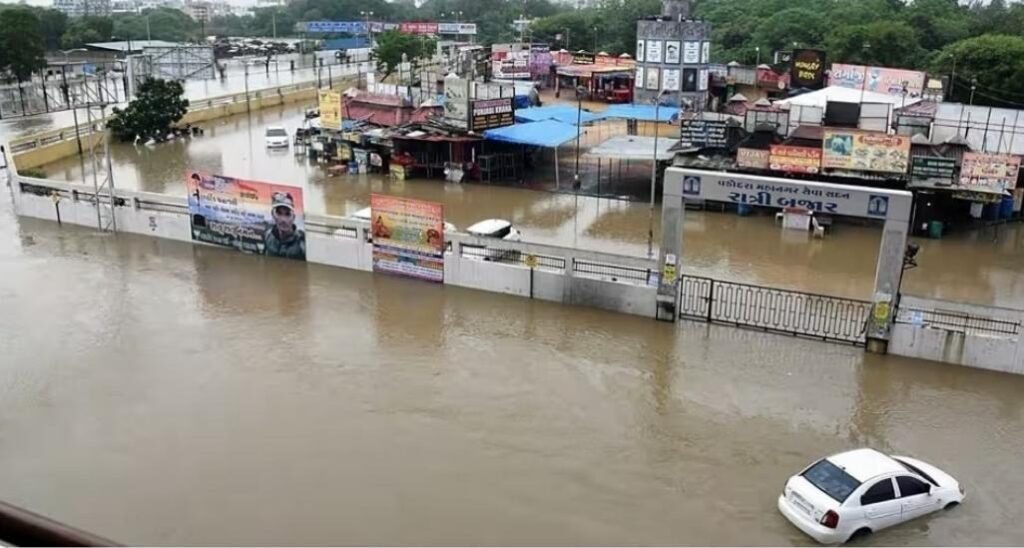
Photo: Ria Gupta
Simultaneously, a movement to spread awareness was rolling; the campaign meant the interested people of Vadodara eventually put their voice behind the rejection of the VRDP. The NGT took note of the fact that the project violated major laws – Environmental Impact Assessment Notification of 2006; sections of the Environment (Protection) Act, the Wildlife Protection Act of 1972, the Wetlands Conservation and Management Rules of 2010, the Municipal Solid Waste Management and Handling Rules of 2000, the Water Prevention and Control of Pollution Act of 1974, and the 74th Amendment to the Constitution of India which empowers local bodies to plan.
As Sarwate says, “soft advocacy didn’t work, the legal route had to be adopted. The petition galvanised academics, subject experts, civil society organisations, and activists into action.” It was this energy and coalition that sustained long after the VRDP was scrapped in 2017. The GHRC taking suo motu action in 2024 gave teeth to the people’s movement. The committee it set up has already submitted three field inquiry reports; it involved the National Highway Authority of India, the National High-speed Rail Corporation implementing the ambitious Ahmedabad-Mumbai bullet train project, and the state irrigation department to ensure that their constructions do not encroach on the river’s riparian regions.
“The intervention of the GHRC provides actionable strength to us in the committee. The Vadodara Municipal Corporation and various agencies are accountable, they attend meetings, accompany us in the field, and implement the necessary correctives,” points out Jitendra Gavali, eminent botanist and former Regional Director, Community Science Centre.[9] Gavali points out that various individuals and groups were working on the Vishwamitri river independently but the VRDP brought them together. For instance, the Community Science Centre’s Vaho Vishwamitri (Do flow Vishwamitri) campaign that he launched in 2009. “Vaho Vishwamitri was an awareness programme but we subsequently made proposals to two chief ministers, Narendra Modi and Vijay Rupani as well as (former president) APJ Abdul Kalam. They didn’t click,” recalls Gavali.
The people’s movement to rejuvenate the Vishwamitri is far from over. But the long campaign and advocacy have educated and energised the youth, led to on-ground monitoring, recording the work done by the municipal corporation, tracking official plans and progress, documenting irregularities, and ensuring accountability.[10]These gains are as priceless as the rejuvenated Vishwamitri. As Sarwate and Raval’s note in their paper, the movement has provided a template for advocacy too: “The case of the VRDP is significant as the multipronged, persistent intercession by the CCV (Concerned Citizens of Vadodara) not only resulted in the withdrawal of the project but set a precedent in the judicial realm towards the scientific understanding of rivers in India. It provides lessons for making course corrections in similar cases and demonstrates that diligent involvement of local citizens and experts along with application of legal tools is crucial for shaping socio-ecological interventions concerning rivers in urban areas.”
Darshan Desai, a veteran journalist with newsroom experience in mainstream publications, is currently Professor-of-Practice, Journalism & Mass Communication, at Navrachana University in Vadodara. He is also the Founder-Editor of Development News Network, Gujarat. (www.dnnonline.in)
Cover photo: Bhavya Choksi

